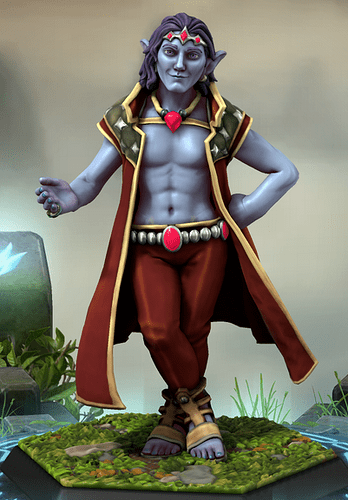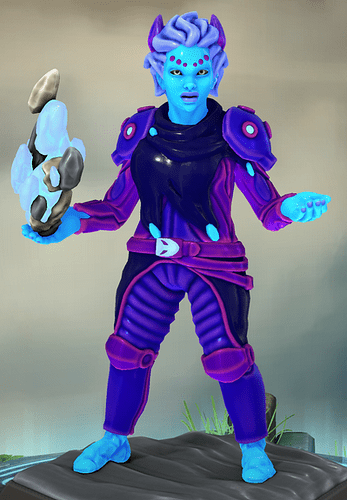Schism
Real Name: Snapdragon Jack, First Appearance: Twilight Carnival (Vol. 3) #4, March 2022
Approach: Adaptive, Archetype: Squad
Upgrade: Inspiring, Mastery: Total Chaos
Status Dice: Based on number of allied villains and lieutenants. 4+: d6. 2-3: d8. 0-1: d10. Health: 25+5H [Upgraded 45+5H]
Qualities: Insight d10, Ranged Combat d8, Magical Lore d8, Fae Tempter d8
Powers: Telekinesis d10, Suggestion d8, Awareness d8, Vitality d6
Abilities:
- Friend And Foe (I): On your turn, whenever you Attack a target you haven’t dealt damage to yet this scene, also Boost yourself using your Min die. If they are an allied villain or lieutenant, use your Max die. Bonuses created this way are exclusive but not persistent.
- Do It For Me [A]: One ally makes a basic action now, using their Max die. They reroll any 1s they roll as part of this action.
- Sow Chaos [A]: Attack multiple targets using Telekinesis. Boost the same number of targets using your Min die.
- You Go First [A]: Boost using Insight. Boost another target using your Max die, and use your Min die to Defend against all Attacks against you until your next turn.
- Don’t Touch The Face [R]: When Attacked, redirect the attack to a nearby ally. Boost yourself by rolling your single Telekinesis die.
- (U) Beguiling Aura (I): When you take an action that lets you make a Boost, also Boost an ally using your Mid die.
- (U) Master of Total Chaos (I): If you are in a situation where everything is spiraling out of control, automatically succeed in an Overcome to accomplish a task by throwing out the rules.
Common Scene Elements:
- Champions of Leafblight: Two monster villains who idolize Schism and hate each other; they compete for his attention in sub-optimal tactical moves.
- Leafblight Courtiers (d10 lieutenants): Leafblight Courtiers have a particular set of monstrous skills, and get +1 to basic actions when using them.
***Note: '*Inspiring’ is a modified form of Group Fighter, which allows a villain to Boost instead of Attacking.
2022 saw the plans that Venture had put into place in the previous year come into effect, initially with good effect. The first comic to be adjusted under the new directive was Veilwalkers. While it had launched strong, the writer’s bout with Covid in 2020 had caused a four-month delay that the comic never fully recovered from. Rather than trash an intriguing premise, the editorial board decided to use it as a test bed for their new approach, and Veilwalkers ended with Issue #30 in December 2021. It was replaced by a planned twenty-five issue run of a new Twilight Carnival, which would blend the most popular aspects of the previous title with fan-favourites who had been given less time in the spotlight since the launch of the Diamond Age.
In the new Twilight Carnival, Veilwalker returned to Lostwood with Eli and Harbinger; Adamant chose to go off on his own to learn more about himself in the aftermath of the previous series’ end. In Lostwood, the three mages were joined by Moon Rider and Winter Wolf to found a new Twilight Carnival, dealing with magical forces that had awakened in the aftermath of the ley lines difficulties of the previous comic. Twilight Carnival was designed to serve as both a sequel and a standalone title, and its primary foes were a town deliberately designed to be a dark mirror to Lostwood’s record of integration and diversity: Leafblight, and its twisted leader Schism.
Schism had been born Dragonsnap Jack, a minor fae with a gift for manipulating others that far exceeded his actual powers. Having visited Lostwood, Jack fell in love – not with the community or its spirit, but with the drama that was always boiling just under the surface. Soon enough, though, he found that the drama wasn’t nearly dramatic enough. He wanted more. He wanted a powerkeg constantly on the verge of explosion, whose residents were at each others’ throats. But when he tried, he was quickly found out, and Winter Wolf roughly expelled him from the town and forbade him to return.
Schism wasn’t put off. He found a ragged collection of humans and monsters that had been deemed too cruel or violent for Lostwood, and then he began recruiting from others on the fringes of society. Anyone with darkness in their hearts and passion in their souls was a good fit for Schism, and soon he had built his own secret town, one that could tear Lostwood down. His city operated like a cult, its residents worshipping his name and swearing that they would destroy everything that Lostwood had built. They launched schemes and plans and sometimes just straightforward attacks, manipulating each other and feuding to gain Schism’s favour and sit at his right hand, and he reveled in it. The attention, the suffering, the pain inflicted in his name, everything that his pawns did was worth the fun.
The most important fact, the one that almost none of his followers recognized, was that Schism didn’t want Lostwood to fall. Its dedication, community spirit, and power served as the perfect wall for his minions to crush themselves against, keeping Leafblight in a constant state of turmoil with an external enemy that Schism knew they had no hope of defeating. The overarching story of Twilight Carnival was about how to stop Schism from causing more harm, while he gleefully told his foes that by gathering all of the world’s worst monsters in one place he was actually doing them a favour. After all… now they knew where the next problem was going to come from, didn’t they?
Behind the Scenes
This guy is such an asshole.
Imagine him just lounging on a chaise, someone feeding him grapes as he idly issues orders. Just running a finger under the chin of some poor dupe. Guy is the worst. He’s going to stick around forever. I don’t actually remember when I decided that I wanted a supervillain whose primarily goal in life was to get his own people killed fighting the heroes, but as soon as I did I knew I couldn’t live without him.
I did try to build a HeroForge model of him lounging, but right now the only chair options are really simple, and you can’t control legs, so it didn’t look good.
I’ve done a lot of minor homebrew here. I’m using my revised lieutenant-based Squad to let Schism have a few more people at his disposal, and I’ve modified Group Fighter to provide Boosts instead of Attacks to amp up the problems. Finally, Sow Chaos is a new Adaptive power that I think fits, and is fun to play with. There are two results here: first, Schism is Boosting a lot, so his allies are going to have some devastating rolls. At the same time, the temptations in Sow Chaos plus the redirects in Don’t Touch The Face make him a bit of a threat to his allies too, and when they go down a lot of his tricks go down with them. Isolated, he’s an easy fight.

